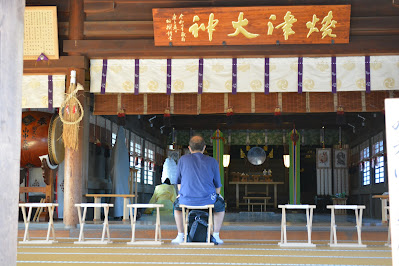On
12th October, hubby and I visited Yaizu Shrine located in Yaizu city, Shizuoka
prefecture. The shrine was founded in 409 AD. During Muromachi period, when
Imagawa clan ruled the province of Suruga (in present day Shizuoka), the area
where the shrine is located was known as ‘Irie no Sho’ and the shrine was
called ‘Irie Daimyojin’. The shrine was patronized by Samurai families like the
Imagawa clan in the Muromachi period and the Tokugawa clan in the Edo period.
This shrine is a source of emotional support for the people of Yaizu area and
for those involved in the fishing industry who risked their life to go fishing.
A
principal statue of Yamato Takeru, a 4th century prince of Yamato dynasty, son
of Emperor Keiko, is enshrined inside. Legend has it that Emperor Keiko sent
him to the eastern provinces, whose officials known as Kuni no Miyatsuko
rebelled against the imperial court. His enemies attempted to kill him by
setting fire to a grassy plain, but he escaped by using the powers of his
magical sword, the Kusanagi no tsurugi and two magic stones. The sword and
one of the magic stones are kept at Atsuta Shrine in Nagoya. Yaizu Shrine
claims to have the remaining stone, as well as to have been built on the
location of Yamato Takeru's escape. In addition to Yamato Takeru’s statue, the
deities of his three main retainers Kibi Takehiko no Mikoto, Otomo no Takehi no
Mikoto and Nanatsukahagi no Mikoto are also enshrined inside.
We
entered Yaizu Shrine premises from the car parking lot, and saw the wonderful
shrine right in front of us. We could clearly see Honden, Heiden, and Haiden
buildings from the car parking lot. All the three buildings are connected
together.
Yaizu
Shrine as seen from the car parking area
Haiden
(front), Heiden (middle), and Honden (back) halls of the shrine
Shrine
premises
The
current Honden Main Shrine Hall was built by Tokugawa Ieyasu in 1603. Tokugawa
clan had a deep connection to the shrine as Ieyasu donated a lot of land and
the shrine territory was guaranteed through many generations. The wooden Honden
has an architectural style of Nagare-zukuri. It has gabled Kirizuma style roof
with short decorative logs called Katsuogi placed at right angles to the
ridgeline of the roof and forked roof finials called Chigi at the corners. The
roof of the hall was replaced with copper plates in 2010.
Honden
Main Hall
Heiden
is a building located between Honden Main Hall and Haiden Worship Hall. Heiden
is used for rituals and Haiden is where worshippers come to pray. There was no
Heiden until 1943, and all the rituals were held in a gravel covered area
between Honden and Haiden. The previous Haiden was built in the middle of the Edo
period and was moved as the worship hall of a nearby shrine named Mitama Jinja.
The current Heiden and Haiden buildings of Yaizu Shrine were built in 1944.
Initially these two buildings had Hiwadabuki style roofing made from layers of
Japanese cypress bark but it was replaced with copper sheets in the 1950s. In
2010, the roofs of Heiden and Haiden were replaced with copper plates.
Hubby
standing in front of Haiden Worship Hall
I am ringing
the bell of Haiden Hall
A
worshipper sitting inside Haiden Hall and a priest (sitting down in yellow robe
on the left side) preparing for some ritual inside Heiden hall
Adjacent
to Haiden of Yaizu Shrine, we saw a shrine named Yaizu Tenmangu. It is
dedicated to Sugawara no Michizane, the god of learning and calligraphy.
Yaizu Tenmangu
Shrine
I am
standing next to the statue of a bull lying down, which is a symbol of Tenmangu
Next
to Yaizu Tenmangu Shrine, we saw another shrine named Mitama. It enshrines the
spirits of more that 2600 heroes from Yaizu who died in battles in Seinan War,
Sino-Japanese War, Russo-Japanese War, and Greater East Asia War. A monthly festival is held on the 15th of each month for the lost
heroes. The current Haiden Worship Hall of Mitama Shrine was originally the
worship hall of Yaizu Shrine and was built in the mid-Edo period. In 1944-45, when Yaizu Shrine was being rebuilt, it was relocated
and became the Haiden Worship Hall of Mitama Shrine.
Mitama Shrine
We saw a statue of Emperor Jimmu adjacent to Mitama Shrine. The statue
was originally located in the Jimmu-dori shopping street. It was built to
commemorate the enthronement ceremony of Emperor Taisho. After World War II,
the statue was moved to the present location and does not have any historical
relation with Yaizu Shrine.
Statue of Emperor Jimmu
We also saw a statue of Yamato Takeru in the shrine precincts. Next to
the statue we saw Sazare-ishi, which is an auspicious boulder formed of tiny
pebbles and has a reference in Japanese national anthem Kimigayo.
Hubby standing in front of the statue of Yamato Takeru
Sazare-ishi
Finally,
we reached the main Torii gate of the shrine. Ideally, we were supposed to
enter the shrine premises from this gate but instead had entered from the car
parking lot area.
Torii
Gate of Yaizu Shrine
We
enjoyed visiting Yaizu Shrine and learning about its history.














No comments:
Post a Comment